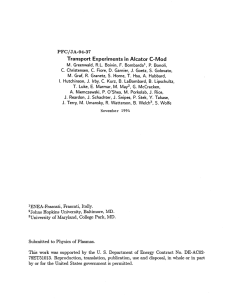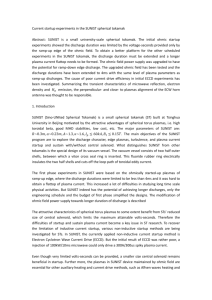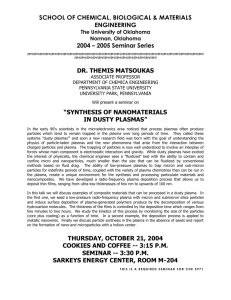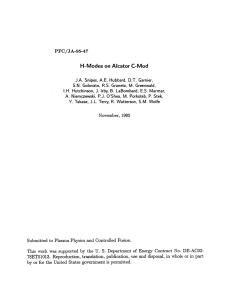Confinement of Ohmic and ICRF PFC/JA-94-29 J.
advertisement
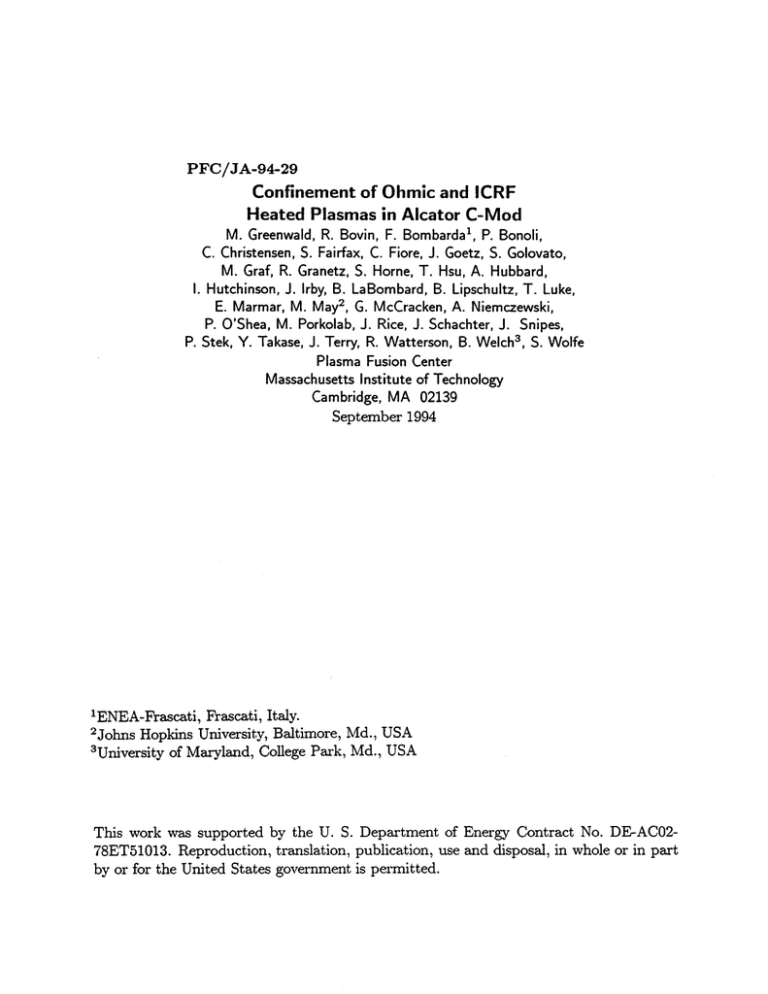
PFC/JA-94-29 Confinement of Ohmic and ICRF Heated Plasmas in Alcator C-Mod M. Greenwald, R. Bovin, F. Bombarda 1 , P. Bonoli, C. Christensen, S. Fairfax, C. Fiore, J. Goetz, S. Golovato, M. Graf, R. Granetz, S. Horne, T. Hsu, A. Hubbard, I. Hutchinson, J. Irby, B. LaBombard, B. Lipschultz, T. Luke, E. Marmar, M. May 2 , G. McCracken, A. Niemczewski, P. O'Shea, M. Porkolab, J. Rice, J. Schachter, J. Snipes, P. Stek, Y. Takase, J. Terry, R. Watterson, B. Welch3 , S. Wolfe Plasma Fusion Center Massachusetts Institute of Technology Cambridge, MA 02139 September 1994 'ENEA-Frascati, Frascati, Italy. Johns Hopkins University, Baltimore, Md., USA 3 University of Maryland, College Park, Md., USA 2 This work was supported by the U. S. Department of Energy Contract No. DE-AC0278ET51013. Reproduction, translation, publication, use and disposal, in whole or in part by or for the United States government is permitted. INTERNATIONAL ATOMIC ENERGY AGENCY k FIFTEENTH INTERNATIONAL CONFERENCE ON PLASMA PHYSICS AND CONTROLLED NUCLEAR FUSION RESEARCH Seville, Spain, 26 September - 1 October 1994 IAEA-CN-60/A2/4-P-2 CONFINEMENT OF OHMIC AND ICRF HEATED PLASMAS IN ALCATOR C-MOD* M. Greenwald, R. Boivin, F. Bombardal, P. Bonoli, C. Christensen, S. Fairfax, C. Fiore, J. Goetz, S. Golovato, M. Graf, R. Granetz, S. Horne, T. Hsu, A. Hubbard, I. Hutchinson, J. Irby, B. Labombard, B. Lipschultz, T. Luke, E. Marmar, M. May2, G. McCracken, A. Niemczewski, P. O'Shea, M. Porkolab, J. Rice, J. Schachter, J. Snipes, P. Stek, Y. Takase, J. Terry, R. Watterson, B. Welch 3 , S. Wolfe MIT - Plasma Fusion Center Cambridge, MA. United States of America * 1 2 3 Supported by US DoE contract#DE-AC02-78ET51013 ENEA-Frascati,Frascati,Italy Johns Hopkins University, Baltimore, Md., USA University of Maryland., College Park,Md., USA This is a preprint of a paper intended for presentation at a scientific meeting. Because of the provisional nature of its content and since changes of substance or detail may have to be made before publication, the preprint is made available on the understanding that it will not be cited in the literature or in any way be reproduced in its present form. The views expressed and the statements made remain the responsibility of the named author(s); the views do not necessarily reflect those of the goiemment of the designating Member State(s) or of the designating organization(s). In particular, neither the IAEA nor any other organization or body sponsoring this meeting can be held responsible for any material reproduced in this preprint. IAEA CN-60/A214-P-2 CONFINEMENT OF OHMIC AND ICRF HEATED PLASMAS IN ALCATOR C-MOD Abstract A series of confinement experiments has been carried out in Alcator C-Mod. We have found that data from both ohmic and ICRF heated plasmas can be fitted with an L-mode scaling law. The ohmic data show no scaling with density in any regime, the tE of these discharges being as much as 2-3 times neo-Alcator. For the small size and relatively high current in this tokamak, L-mode confinement is often larger than neo-Alcator. With ICRF heating, confinement degrades with increasing power approximately as P 0j'~. Overall, the confinement properties of the ohmic and ICRF plasmas are apparently distinguished only by the level of input power. Ohmic and ICRF H-modes are obtained over a wide range of discharge parameters, extending the range in the international database for surface power density, P/S, by almost a factor of 10. The power threshold for elm-free discharges was in rough agreement with the old ITER database scaling P/S = .044 nB. Elmy H-modes were obtained at powers at least a factor of two lower than the elm-free ones. These results were obtained with all molybdenum plasma facing components and no special wall treatment or coating. 1. Introduction The Alcator C-Mod tokamak is a compact high field device capable of producing shaped diverted plasmas. Confinement studies have been carried out in hydrogen and deuterium plasmas with .35 < Ip(MA) < 1.05; .20 < a(m) < .24; .65 <R(m) < .70; 3.5 <BT(T) <5.4; .7 < ne(10 2 0m-3 ) <2.4; 1.1 < K < 1.6. The Zeff is low, typically <1.5 for ne > 1.5x 1020. All of the plasma facing components are made of molybdenum with no special wall treatment or coating. Plasma stored energy is calculated by integration of the density and temperature profiles and by analysis of the MHD equilibrium. These generally agree to within 20%, 2 however for ICRF plasmas, Wmhd is systematically higher than Wkin. This systematic difference is probably attributable to energy in the minority ion tail. When "no plasma" shots are available for subtraction of stray field effects, we can also obtain the stored energy by analysis of the diamagetic loop signals. These are in good agreement with Wmhd. Shots for confinement analysis were chosen with "standard" criteria: quasi-steady state, sawtoothing, and nondisruptive. 2. Ohmic L-Mode Confinement Early in our experimental campaign, clear differences between Alcator C-Mod and its predecessor Alcator C emerged. In the ohmic plasmas, stored energy increased with Ip but not with ne. Figure 1 shows the measured TE plotted against the calculated neo-Alcator TE[I]. Note that for most discharges, the measured TE is greater than the neo-Alcator value. The increase in stored energy with Ip suggested an L-mode behavior; figure 2 shows the measured TE plotted against T ITERP-89[ 2 ]. The agreement in this case is clearly much better. Our conclusion is that our ohmic confinement is following an L-mode like scaling which for low densities and high currents can exceed neo-Alcator by as much as a factor of 3. T VS TeoAIctor - Ohmic Plasmos 0.050 TE vs ' 0.040 - T - Ohmic Plosmos 0.050 0.040 0.030 - 0.030 9 0.020 - 0.020 0.010 - Hydrogen 0.010 y rogen Deuterum F 0.000 L'.- _L_ 0.000 0.010 0.020 0.030 0.040 0.050 0.060 re = 4 .166 n.R"o0-A ic" (s) Fig.1) Measured TE vs TE(neo-Alcator) scaling for ohmic data. The data do not show agreement with the scaling. Deutenumn 0.000 . 0.010 TMW= 0.020 0.030 0.040 0.050 .048 IpORloaxn.* Btuamu"P~ (s) Fig.2) Measured TE vs TTR89.P) for ohmic data. 3 A linear regression can be performed to calculate the best fit to a power law scaling for the C-Mod data alone. The range of some parameters (a, R, BT) in our data base is too limited to include in the regression, however significant results were obtained by fitting against Ip, PRot, ne, K, and amu (effective ion mass). It should be noted that there are significant covariances in the database. In particular Ip, ne, K, and amu are generally correlated. Of course for the ohmic data there is an additional correlation between Ip and Poh. The results, which include data for ICRF plasmas, are shown in figure 3. The coefficients are not distinguishable from ITER89-P within the error bars of the two fits. T Measured tE Fig.3) Measured 'TE vs power law regres- 0.06p.-* Ao = 0.027 data are included. The coefficients are essentially the same as for ITER89-P within the error bars. T qnu Ip z ne Ptot) =.44 * 0.04 -7i= 0.79 k0.05 7, 0.26 1 0.12 sion, fitting to Ip, K ne, Ptot, and amu (ef- fective mass). Both ohmic and ICRF KIN VS 0.04 -71, 0.30 ± 0.03 7p = -0.60 * 0.02 R 0.944 0.02- 0 ICRF Ohmic 0.00. 0.00 0.02 *m 0.04 (fit) = 0.027 Amu0"Ip-"xne0"Ptot- 0.06 3. ICRF Heating and Confinement ICRF heating was performed using a dipole antenna (two current straps spaced toroidally and driven out of phase) with up to 2 MW of power at 80 MHz. The heating scenario was hydrogen minority heating in deuterium at Bt = 5.3 T. Efficient heating was observed, roughly doubling electron and ion temperatures at the higher RF powers. There were substantial variations in the relative temperature increase of the electrons and the ions. The minority concentration was typically around 10% but was not well controlled or characterized in these experiments. The energy of the ion minority tail should decrease at higher density and minority fraction, resulting in less slowing down on the electrons and more 4 (indirect) ion heating. Evidence so far suggests such a correlation but is not conclusive at this point. Shot #940602019 Confinement Times - Shot#940602019 0.6 40 TO(O) S0.050 r~o) 0.040 0.030 0.020 0.010 0.000 2 0.0 1 2.1 . 0.2 . . . . . 0.4 Tujit - Tou..no 0.8 1.0 Time (sec) F 0 0.6 - -. 0.50 Fig.5) Measured TE vs time for the plasma _ _0_ 0.60 Time (sec) 0.70 0.80 Fig.4) Time histories of Te(0), Ti(0), ne, Zeff, and Picrf for shot 940602019 shown in figure 4. tE neo-Aicator and TE iTER89-P are included for comparison. The transients seen at the time of RF turnon and turn-off are artifacts of the long averaging period for the ECE data. Traces of Te(0) and Ti(0) vs time are shown in figure 4. The electron and ion temperatures are strongly modulated by sawteeth activity. The sawteeth themselves are modified, their period increasing by factors of 2-4 over otherwise similar ohmic plasmas. Despite a small increase in density and Zeff, Prad/Ptot is unchanged. Figure 5 shows traces of the calculated TE vs time - the data follow Lmode scaling right through the ohmic and ICRF phases. This point is reiterated in figure 6, where the stored energy is plotted vs total input power for several ranges of Ip. In figure 5, the larger value of TE determined from the MHD equilibrium calculation is likely due the effect of the ion tail energy. 4. Local Analysis Initial runs of the TRANSP[3] code have been performed. For the ohmic shots at Ip = .8 MA, ne = 1x10 2 0, we have found Xe(a/ 2 ) - 0.5 m 2/sec. At low densities, where electron and ion transport can be separated, Xi ~ Xe and is 5 mildly anomalous with Xi/Xneo = 1-3 with large uncertainties. For a typical ICRF plasma, with Prf = 1.8x106, Ip = .8 MA, and ne = Ix I , the calculations show approximately 90% of the RF power is thermalized within r/a = .5 and an ion tail with approximately 10-15 U out of a total stored energy of 60kJ. This is in good agreement with measurements of AW from kinetics, MHD, and diamagnetism. For the ICRF plasmas, Xe rises to about 1.3 with little change in Xi. Stored Energy vs Total Input Power DL) Fig.6) Plasma thermal energy vs total input power for various ranges in Ip. The solid lines shown are ITER89P scaling. 0 0 40 a' Li 0 C 20 0 0 0 0.8 MA - ICRF M 0.6 MA - ICRF 00.8 MA - Ohmic 0 O0.6 MA - Ohmic A 0.4 MA - Ohmic ... , . ... A 0.4 MA - ICRF .. ,.... 1 .. 2 3 Input Power (MW) 5. H-mode A series of experiments was carried out to look for H-mode in ohmic plasmas. Because C-Mod operates at much higher toroidal field and density than other tokamaks, it offers the opportunity to significantly expand the international database. With the ion grad-B drift toward the divertor, clear L-H transitions were observed. Further efforts to lower threshold power by ramping down BT to 3T and lowering the density, resulted in the achievement of elm-free H-modes[4]. Accompanying the transition was a drop in Ha light, a strong rise in density and stored energy, a steepening of the edge profiles, and a decrease in edge turbulence. A plot of C-Mod data vs the "consensus" scaling P/S = .044 nB[5 is 6 shown in figure 7. While the elm-free data agree well with the empirical curve, elmy H-modes were obtained at substantially higher values of nB. No boronization or other coating on the all molybdenum first wall was necessary to obtain these results. There are some indications that lithium coating, the remnants of lithium injection experiments, may lower the power threshold further. H-Modes were also achieved with ICRF heating[8] with similar power thresholds as seen in the figure 7. ICRH and Ohmic H-Mode Threshold Fig.7) H-mode threshold data for ohmic and ICRF discharges. The dashed line is the ITER scaling P/S = .044nB and is a good fit to our elmfree data. Results from DIII-D[6] and ASDEX-UG[7] are shown for comparison. - ELM Free OH o ELMy OH o 0.3 - $ E ~ )K ELMy OH (Li Inj) NE - X ELMy ICRH CN 10 ELM Free ICRH E)K .1 0.2 NE: ,-_-P/S CLC,) = .0044nB 11 1-1 3 0 0.1 DIlD (Osborne et al. Nucl. Fus. 90) ASDEXU (Ryter et al. EPS 93) 0.0 0 20 40 nBT (10 9m 80 100 ,T) The elm-free periods were short lived, lasting typically 50 msecs. These were limited by an uncontrolled density rise and disruptions as q(a) dropped near 2 (due to the BT ramp). While the energy confinement showed a large increase during the elm-free periods, it was not possible to make definitive measurements due to the strong transients. TE in the L phase of these plasmas was around 30 msec. After the L-H transition, TE rose to 50-100 msec. The latter figure comes from including the plasma dW/dt term which could be as large as 60% of the input power - thus the plasmas conditions were far from steady state. The ITER Hmode TE for these plasmas is around 55 msec [9] 7 References [1] PARKER, R., GREENWALD, M., LUCKHARDT, S., et al., Nucl. Fus. 25,9 (1985) [2] YUSHMANOV, P.N., TAKIZUKA, T., RIEDEL, K.S., et al., Nucl. Fus. 30, 10(1990) [3] HAWRYLUK, R., Physics of Plasmas Close to Thermonuclear Conditions, Proceedings of the course held in Varenna, Italy, Vol.1, pg.19 (1979) [4] SNIPES, J.A., GRANETZ R.S., GREENWALD, M. et al. to be published in Nuclear Fusion (also available as PFC/JA-94-02) [5] RYTER, F., (for H-mode database working group), Cont. Fus. and Plasma Phys. Vol 17C, 1-15 [6] OSBORNE, T.H., BROOKS, N.N., BURRELL, K.H., et al., Nucl. Fus. 30, 10 (1990) [7] RYTER, F., GRUBER, 0., BUCHL, K.. Cont Fus. and Plasma Phys. Vol 17C, 1-23 [8] SNIPES, J.A., GRANETZ R.S., GREENWALD, M. et al. to be published in Proc. 21st EPS, Montpelier, 1994 (also available as PFC/JA-94-20) [9] KARDAUN, 0., et al. (for H-mode database working group), Proceedings of 14th IAEA Conference on Plasma Physics and Controlled Nucl. Fusion Research.,. Wurzburg, Vol. 3, pg 251, 1992 8

